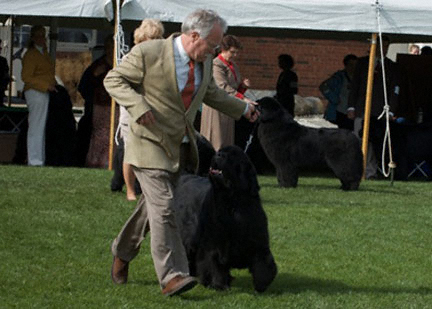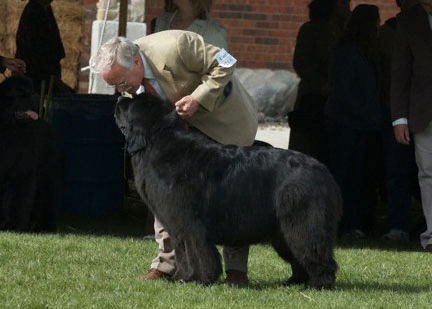Owner-Handlers: How to Get Going! by Joan Gunn
 Conformation is a word that is misspelled a lot. One easy way to remember its correct spelling is to remember what a dog show is really all about. It is an opportunity to get the opinion of the judge as to how well your dog "conforms" to the standard, the ideal Newfoundland. The dog and bitch who conform the most, win the points for the day. Sounds easy, right?
Conformation is a word that is misspelled a lot. One easy way to remember its correct spelling is to remember what a dog show is really all about. It is an opportunity to get the opinion of the judge as to how well your dog "conforms" to the standard, the ideal Newfoundland. The dog and bitch who conform the most, win the points for the day. Sounds easy, right?
I have shown and finished dogs from the bred-by class for several years. While I still do not consider myself an expert by any means, I will share some things I have learned along the way. I see four important areas: training, conditioning/exercise, diet/supplements, and grooming.
Training
Hopefully, you have found a good specimen of the breed. A puppy is such fun and they love to learn new things. At an early age, begin teaching them about the grooming table, grooming, stacking, and walking on a lead next to you. Puppies who have been through a couple of obedience classes are much easier to teach ring behavior to; they are also more pleasant to live with. A good conformation class is an absolute must. Not just a "run-through" class, which seem to be very popular and great once you have gotten experience, bur a class with an instructor who will teach you how to show your dog.
 Every dog is different. Some look better moving more slowly, some can easily learn to gait on a loose lead (a favorite look to my mind), and stacking can also be a little different from dog to dog. You also need to learn ring etiquette. You need to find someone who will take the time with you and your dog. Showing is a very learnable skill, but it does take time, so be patient with yourself and your dog.
Every dog is different. Some look better moving more slowly, some can easily learn to gait on a loose lead (a favorite look to my mind), and stacking can also be a little different from dog to dog. You also need to learn ring etiquette. You need to find someone who will take the time with you and your dog. Showing is a very learnable skill, but it does take time, so be patient with yourself and your dog.
I like to give a puppy some ring experience at about seven to eight months of age, either at a dog show or fun match. It is just that-experience. If they wiggle and won't stand still, that's OK. If the judge does not understand that this is a puppy with little ring experience, don't show to that judge again. Judges need to be nice people, too! Your goal here is for the puppy to have a wonderful time, and earn lots of cookies. Hopefully he will gait around the ring. Puppies can make almost anyone look foolish. So have a big smile and enjoy. While puppies can be fun to show, my first show dog was out before she was really ready. I had fun but didn't win. If you want to increase your odds of being the one who does go home with the points, wait until your dog is mature, somewhere between two and three years old, before you do it seriously. But in the meantime, keep up with the conformation classes and get your dog to a few small shows. Keep notes on judges and don't be afraid to vote with your feet. Impolite, rude or political judges? Don't go back. Judging would be better if we all did that.
Conditioning and Exercise
Conditioning and exercise are very important. Never force a puppy or young dog to exercise. Their bones and their minds are simply not ready. Hopefully you have a space large enough for your dog to run around in. Puppies usually exercise themselves-they make up games and race around. As your dog matures, you need to be sure he becomes well muscled. Some dogs need more conditioning than others. Some love to run and gait around and they do it themselves. Others are more sedentary. They need walks, gaiting (a golf cart works great), and running up and down hills is wonderful. I have found there is nothing like working activities to muscle up a dog. Swimming is wonderful exercise-you do have to take extra special care of the coat, though. Drafting is another great exercise. It builds front and rear muscles. I have found that drafting even improves toplines.
Diet and Supplements
Diet and supplements are terribly important. A healthy dog with healthy skin will have a healthy coat. I feed a "fresh food diet." I am a nut about it. It is based primarily on Ian Billinghurst's Grow Your Pups with Bones and is commonly referred to as the BARF diet. This diet attempts to replicate what dogs would eat in the wild if they had the opportunity. I use a lot of green vegetables, (kale is excellent), with my raw meat and bones. I supplement with flax oil, evening primrose oil, zinc and seaweed mineral formula as well as vitamin C and E. I also use a lot of garlic and some apple cider vinegar in their food. I find it keeps away parasites including fleas. I guess they can't stand the smell either!
Grooming
Frequent grooming is also important. Before any bathing, a dog must be combed through and free of knots and mats. Coats should be lightly misted before brushing, it keeps hair from breaking off. Tools I like to use: comb with a comfortable handle, boar and bristle brush, slicker brush, rake, mat rake (the kind with razor sharp four-inch long teeth), and a greyhound comb, preferably the Teflon coated one. For general grooming (not right before a show), I use a slicker brush and large-tooth comb. Whenever grooming, groom down to the skin. Part the hair as you work and comb or brush from the skin out. Conditioning sprays help a lot. An easy and economical one can be made of five parts water to one part Mane and Tail Conditioner in a spray bottle. Others I like are Miracle Coat Lusterizer and Conditioning Spray and EQuss Coat Shine. Horse products are generally less expensive and have fewer chemicals in them. Horses are very sensitive to chemicals. For mats, you can't beat Cowboy Magic Detangler (also a horse product). For furnishings that have become dry and brown-tinged, I find a little mink oil combed in helps to bring them back. A good quality moisturizing shampoo should be used. I use One Earth Herbal Shampoo. It smells great and rinses out easily.
Blow drying a large dog can take longer than the rest of the grooming session. Do not use a super high velocity dryer. I find it dries the coat too much. I use a lower velocity without the intensifier (little nozzle). Brush or comb the coat in the direction of the coat as you dry. I like the boar bristle brush for this. For a wavy coat, use the boar bristle brush, pull the coat up from underneath, and dry pulling away from the skin, the same way you would your hair. Thoroughly dry your dog. Now go in and rest your arms. I usually try to do the trimming the next day or later in the day.
Trimming: How much is enough? How much is too much? I think of the Newfoundland as a "natural" dog. Yes, they should be tidied up, with the ears, feet, bib, hocks and feathers neatened up. For trimming, I have three pairs of scissors: long straight scissors (they are cheap and junky-I use these primarily to trim hair between pads of feet); a pair of three-inch long straight scissors, and a pair of thinning scissors. A good pair of thinning scissors is important both for the cut and the sake of your hand. A good pair usually run $80 plus, but they are worth every penny. When using thinning scissors, trim from the bottom up on ears and bib. You don't want to cut guard hairs. For areas where there is just too much coat, sometimes on the rump, the mat rake will take out extra coat and not cut the guard hairs. Comb through with a smaller-tooth comb.
Why all this fuss about not cutting guard hairs? There are a couple of reasons. The coat is an important part of the standard: double, water resistant, lays flat when ruffed. It is not an open coat. When guard hairs are trimmed, it is impossible for the judge to properly evaluate the coat. A well known handler maintains that cutting guard hairs opens the hair shaft and thus makes the coat no longer water resistant. Look at a guard hair. It tapers at the end and allows water to run off. Why would you cut the guard hairs?
Sculpting is another issue. Here a dog's coat is blown dry to create an open coat and guard hairs are cut to where the undercoat begins, giving the coat a "plush toy" effect. Hair is trimmed in such a way as to enhance/change angulation of stifle, hock, shoulder or change apparent proportions of the dog. The Illustrated Standard says excessive trimming is not encouraged. I personally think this, along with the recent use of electric clippers, is excessive. It is true that a good judge will not be fooled by trimming. But if you find yourself needing to cut in (sculpt) a shoulder set, a hock, a stifle, and legs, perhaps you should go back to the correct spelling of the word. It is "conformation!'
Showing your dog can be a lot of fun and an enjoyable experience. It takes some time and patience to learn the skills, but the fun and joy of finishing your own dog make it all worth it. Have fun and good luck at your next show!
reprinted from NewfTide 2002, Images © Chad Perry 2009, used with permission